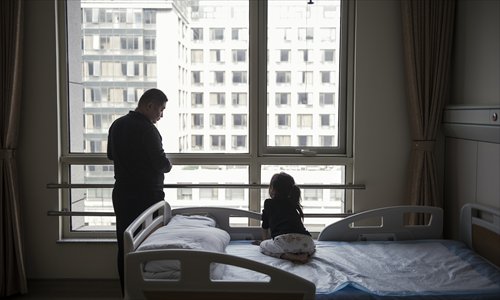

According to the World Health Organization, the incidence of childhood cancer globally is around 160,000 new cases each year. Photo: Li Hao/GT
Malignant tumors in infants are often curable, but support from Chinese health system leaves much to be desired
When Jin Huizi took her 11-month-old daughter Niu Niu (pseudonym) to the Beijing Children's Hospital in June, it was only supposed to be for a common cold.
Instead, Niu Niu was made to undergo an ultrasound scan, after the doctor noticed that the infant girl's stomach was abnormally swollen.
"The examination revealed that there was a large, unknown tumor in my daughter's abdominal cavity," said Jin.
Jin was required to go back to the hospital on the following day. After further tests, Niu Niu was diagnosed with hepatoblastoma, a rare liver cancer that occurs only in children, usually in the first three years of life.
Jin and her husband were distraught. Both had led healthy lives, so it was unimaginable to them that their daughter could have cancer. They were told that cancer in infants usually spread much more rapidly, progressing from early stage to late stage within a period of three months.
Fortunately for them, the cancer was discovered early. There was still hope that their girl would survive.
The facts about childhood cancer
According to an informational package published by the World Health Organization (WHO) in 2009, there are around 160,000 new cases of cancer discovered in children (under the age of 15) every year, and 90,000 deaths in children resulting from cancer.
The report goes on to list a number of qualitative differences between cancer in children and adults, based on the fact that children are exposed to different environmental factors, and that their physiology, which has not yet matured, will respond differently to environmental factors.
"Children can not be diagnosed and treated as if they were just little adults," said Wang Jiayi, a doctor in the oncology department of Guangzhou Women and Children's Medical Center.
As for the causes of childhood cancers, the WHO report identified familial and genetic factors and known environmental factors as accounting for up to 25 percent of cases.
The causes for the other 75 percent of cases is currently unknown, although ongoing studies have speculated that exposure to chemical substances, heavy metals, and types of radiation not currently known to be linked to cancer could be contributing risk factors.
Despite the failure to attribute the majority of cases of childhood cancer to a known cause, the efficacy of treatment in developed countries is quite high.
According to the American Childhood Cancer Organization, the overall five-year survival rate for childhood cancer is 80 percent in the US.
The situation in China
Deng Qinghua, director of radiology at the Hangzhou Cancer Hospital, said in comments made to the Today Morning Express in November that the incidence of childhood cancer in China has risen from about 1 out of every 10,000 children in the 1980s to 2.13 out of every 10,000 children.
Each year, 60,000 to 70,000 children are diagnosed with cancer in this country, according to the report.
Treatment of child cancer in China however, said Wang, remained hampered by poor medical infrastructure.
"At the moment, in China, the resources and infrastructure for treating childhood cancers is rather poor," said Wang. "Because there's no medication in China that has been made specifically for children, treatment consists of a reduced dose of medication that is meant for adults. There is a drastic lack of funding, specialized hospitals and specialist doctors."
A report published in October in the Dahe Daily noted the shortage of oncology departments in general hospitals, which meant that such hospitals would frequently turn away children diagnosed with cancer due to an inability to adequately treat them.
Jin, who signed up to a number of online support groups after her daughter's diagnosis, said that another common problem was a lack of understanding about childhood cancer. "[Often], the initial symptoms are common things like fever or stomachache, and it never occurs to parents that their child might have a tumor," said Jin.
"To save more children from dying of malignant tumors, our country needs to pay more attention to these little patients," said Wang. "The government, hospitals, and the health sector all need to do their part."
Copyright ©1999-2018
Chinanews.com. All rights reserved.
Reproduction in whole or in part without permission is prohibited.